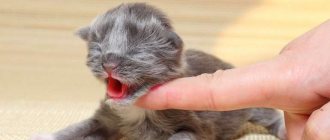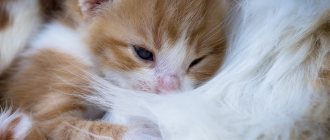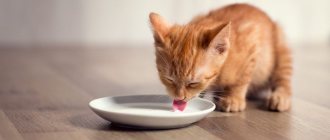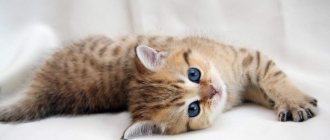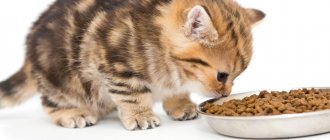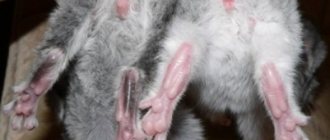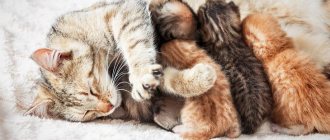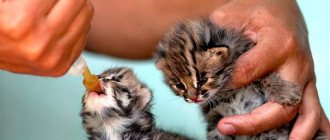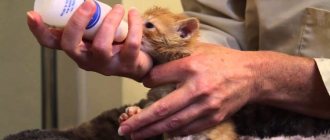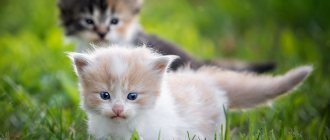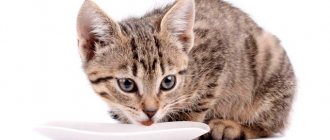For strong immunity and the proper formation of a kitten’s internal organs, nutrition plays an important role, starting from the first days of life. Mother's milk, which is secreted during lactation, provides babies with all the necessary nutrients, as well as immunocompetent cells that protect the body from many diseases.
If a kitten is left without a mother at an early age, special attention should be paid to its feeding.
Growth stages and needs of kittens from 0 to 30 days
In the first month, kittens experience processes of growth and development of the body; proper care during this period allows them to improve their health and avoid diseases in the future.
- The neonatal period lasts from the day the baby is born until 10 days. At this time, rapid noticeable changes in internal organs and external signs occur. Newborn kittens navigate thanks to two sensory systems - tactile and olfactory, since their eyes are closed and the auditory canal is not fully formed. Babies spend most of their time sleeping. Around the fifth day, the kitten begins to hear.
- The transitional stage begins at day 10 and lasts until day 20. At this time, kittens open their eyes, which means the central nervous system is maturing. It is believed that this stage is favorable for establishing good contact between the owner and the pet. Veterinarians recommend teaching your baby to hold hands. From the 10th day, the time spent with the owner should be about 4 minutes; as they grow older, the duration reaches 40 minutes a day. Regular communication with your pet is the key to a friendly relationship.
- The socialization stage begins when the baby takes his first steps. From this moment on, it is easier for the kitten to learn about the world around him. At the same time, the formation of the nervous system, adaptation mechanisms and socialization occurs.
How much food is needed to feed kittens?
The daily portions should be the same as what the cat would give when feeding the young on her own. A proper dosage of food will contribute to the baby’s good health, and overeating or, conversely, too small portions will cause anxiety in the kitten. Once every few days you need to increase the portion sizes.
In order not to make a mistake in determining the optimal amount of food for an animal, you should adhere to the following scheme:
- From the moment of birth until 5 days of a kitten’s life, the daily volume of food should be calculated as 30 ml per 100 g of animal weight.
- Over the next 10 days, food portions must be gradually increased, bringing their total daily volume to 38 ml per 100 g of weight.
- Starting from the 15th day, you can increase the daily volume of food to 45 ml per 100 g. Give the kitten this amount of food until the 24th day of its life.
- Then, over the course of 30 days, the dosage should increase to a total volume of 55 ml per day.
Mandatory and unconditional compliance with the above scheme is not required at all. Animals, like people, also have individuality, which is why the volume of portions eaten by kittens born from the same cat can differ significantly. By carefully observing your pet and getting used to it, you can determine how much food it needs.
How to determine age, make a nest
The age of kittens is determined by several criteria:
- in the first three days a fresh umbilical cord is detected, later it falls off on its own;
- eyes open one and a half to two weeks after birth;
- the reaction to sounds appears from the fifth day, in addition, age can be calculated by the state of the ears - they are pressed to the surface of the head until the ear canal opens, then straightening occurs;
- by the third day of life, the baby weighs on average 100 g, after a week the weight gain is approximately 50 g, at the age of one month the baby’s body weight is 250 g;
- milk teeth appear in two-week-old kittens - the incisors grow first, then the fangs at the fourth week, all milk teeth appear by 4 months.
To create a cozy nest for kittens, you can use a small cardboard box. Since pets at an early age have a small body weight and an immature thermoregulation system, it is recommended to take care of heating.
For this purpose, use a heating pad and a cloth that is placed on the bottom of the box. Favorable temperature conditions range from 25 to 28-29 degrees.
Rules for feeding two-week-old kittens without a mother
Despite the fact that in cats, especially with proper care and maintenance during pregnancy, childbirth proceeds normally and the maternal instinct is well developed, for various reasons kittens can be left without a mother.
Therefore, it is important to know how to properly artificially feed kittens from the first days of life and the basic rules for feeding two-week-old kittens without a mother.
If the kittens are left without a cat, caring for newborn kittens requires serious organization and certain knowledge. Up to two or three weeks, orphaned kittens are absolutely defenseless creatures, so take care of their comfort and health. Undoubtedly, the first weeks will be very difficult for you, especially if you have no experience in dealing with animals.
The rules for feeding kittens at two weeks depend on their condition and development. At this age, the umbilical cord dries up, the shape of the eyes is clearly visible, or the kittens have already opened their eyes, and the first milk teeth are erupting.
Whole cow's milk is not suitable for artificial feeding. Kittens up to three months old have a very sensitive and vulnerable digestive tract. Lactose (milk sugar), fats, is not digested in the kitten's gastrointestinal tract and can lead to severe intestinal upset, health problems and even death.
You can use only special industrial formulations for kittens, cat milk substitutes, or mixtures prepared independently according to the recipes given in this article for feeding and subsequent complementary foods.
For up to a month, especially in the first three weeks of an animal’s life, maintain a feeding regime 24 hours a day. Any errors in nutrition or disruption of the schedule will provoke developmental delays and can become causes of systemic disorders and pathologies in the future.
Important! Competent care, organization of nutrition, adherence to the regime and daily routine are the key to the health and normal growth of kittens who are left without a mother cat.
Food for kittens should always be fresh. It is better to correctly calculate the portions in advance and give the kids fresh food. The mixture is warmed to room temperature before eating. Prepared food should not be stored in the refrigerator for more than 24 hours.
Some tips for caring for orphaned kittens
In addition to proper feeding, create favorable safe living conditions for your pets.
- Keep your kittens warm by providing them with a comfortable home. The temperature in the nest should not fall below 27-26 degrees. Provide heating using a heating pad wrapped in cloth, a towel or a special lamp. Without heating, metabolism slows down and babies can die.
- Before feeding, determine the kitten’s temperature by touch, which should not be below 35 degrees. Only warm kittens can be fed. Otherwise, food absorption and metabolic processes slow down.
How to feed newborn kittens
To feed a kitten without a cat, you should purchase a special formula. Veterinarians do not recommend giving newborns cow's milk and fermented milk products. To do everything correctly, you must adhere to several rules.
- First, the pet is carefully placed on its stomach.
- The milk mixture is fed using a pipette, a bottle with a nipple at the end, or through a syringe without a needle. The food is preheated to a temperature of 36 degrees.
- Feed should be fed dropwise in several passes so that the baby has time to make swallowing movements.
- After feeding, to stimulate urination and defecation, gently massage the abdominal area and anus with a finger or cotton wool soaked in warm water.
Nurse cat or artificial feeding
When deciding how to feed a newborn kitten without a cat, you need to understand that a wet nurse is the ideal solution for both the smallest kitten and its owner.
As a rule, a nursing cat accepts one or more babies easily.
The main thing is to know that the mother and her kittens are healthy and will not infect the babies with infectious diseases, in particular ear mites .
Important! Colostrum, which a cat feeds its kittens in the first two days, is usually not enough. If your kittens are older than those she is nursing, you will need to continue feeding the babies until the nurse begins to produce enough milk.
Feeding frequency and weight gain
Small pets require large energy expenditures, since it is in the early stages that the growth rate reaches its maximum. This situation requires frequent meals - up to 5-6 times a day. As they grow older, the number of meals decreases - at 3 months it is recommended to feed a kitten three times a day.
Upon reaching six months, the animal is fed, like adults, twice a day. It is important to take into account your baby's weight gain; to do this, you should weigh him once a week. Stunted growth may indicate poor diet or illness.
Is it true that artificial kittens get sick more often?
There is a persistent myth according to which kittens deprived of their mother's milk will suffer from some illness throughout their lives. Allegedly, they have extremely weak immunity and a digestive system that has been torn since childhood.
As usual, there is some truth here. Breast milk is really difficult to replace with artificial formula, and the consequences of such feeding can appear years later. But think about this - millions of human babies are raised on formula and are no different from those people who were breastfed as children.
Kittens receive protection from infections from mother's milk only in one case - if antibodies to viruses are in the blood of the cat itself. This is called colostral immunity. If a nursing cat has not been vaccinated, then her kittens are just as defenseless against viruses as bottle-fed kittens. Babies receive preventive vaccinations as early as possible (the first at 2 months with revaccination at 3 months). And complementary foods are introduced as quickly as possible, nevertheless continuing to give a cat's milk substitute for up to 1.5-2 months.
Rumors about the illness of orphaned kittens have a different background. For example, a pregnant cat was starving, which prevented the correct formation of the fetuses.
If the cat lived in good conditions, and the kittens received good genes from both parents, then artificial feeding will not prevent the babies from growing into beautiful and healthy animals.
Features of feeding by month
In the first month, the kittens' diet consists of dairy products, to which other foods are gradually added. In the second week, complementary foods in the form of meat broth begin to be introduced. As the kitten grows, it is fed minced poultry meat. It is also recommended to give various cereals and egg yolk.
From 1 month onwards, the diet includes more solid food - meat cut into small pieces, fruits and vegetables.
By 6 months you should stop drinking milk in its pure form. This is due to the fact that the kitten noticeably decreases the secretion of the enzyme lactase, which breaks down disaccharides, so diarrhea, vomiting and general malaise occur when using the product. Milk is replaced with fermented milk products - fermented baked milk, cottage cheese.
As you grow, other foods besides the mixture are included in the diet; nutrition can be:
- natural;
- ready;
- combined.
For kittens, both the regimen and the feeding process itself are important. Insufficient food can lead to exhaustion or impaired development of the pet. Failure to follow feeding rules leads to aspiration of the respiratory tract with food and other pathologies.
Difficulties and errors
The main and most serious mistake is a frivolous attitude towards what and in what quantities you feed the kitten. This can lead to serious problems with his health.
Pay attention to the position in which the baby eats. If you place it on its back, the mixture may enter the lungs while eating, and this often leads to death. It happens that milk comes out of the nose and the stomach swells greatly - this means that the baby has swallowed a lot of air and is trying to burp. During feeding, be sure to ensure the correct position.
If it is still acceptable to feed a kitten with a syringe at the initial stage, then experts do not recommend doing it from a spoon - such actions can lead to the fact that the sucking reflex disappears, and the baby will not be able to eat normally in the future.
Natural nutrition
Natural feeding implies a diet consisting of natural products. Contrary to popular belief, pets should not be fed from the owner's table; such feeding can lead to the development of diseases.
When choosing a natural diet, veterinarians advise consulting with them in order to correctly calculate the menu for your pet. Excess or deficiency of substances can lead to disruption of growth and development processes, and junk food provokes the formation of diseases.
Features of the natural diet of kittens
For a carnivorous predator, sufficient protein intake is important, so the basis of the diet is meat. Veterinarians recommend feeding chicken, turkey or beef, as these varieties contain the least amount of fat.
Weak meat broths are given to babies from the second week. Soft minced meat is gradually introduced, and from a month on you can feed your pet finely chopped fillet.
For proper osteosynthesis, that is, the development of the bone apparatus, as well as the formation of teeth, a sufficient amount of calcium, magnesium and other elements that are contained in dairy products is necessary. The kitten's diet includes fermented baked milk, cow's milk, and cottage cheese.
Vitamins are found in fresh vegetables and fruits. At an early age they are served as a puree. By one month, the kitten can eat finely chopped ingredients.
The source of phosphorus is fish. Preference is given to marine species. In this case, the product is boiled and cleaned of bones. It is more advisable to use fillet.
Advantages
Supporters of natural nutrition explain their choice by the fact that natural nutrition does not contain harmful compounds - preservatives, additives, dyes, flavor enhancers. In addition, a wide variety of foods has a beneficial effect on your pet's health. With a properly designed menu, natural feeding ensures a complete supply of all necessary nutrients.
Flaws
Feeding your pet natural food can lead to poisoning if a prohibited product gets into the diet. In addition, independently compiling a menu may not take into account the individual needs of the baby and lead to a deficiency of vitamins and minerals or, conversely, their excess.
What to feed a newborn kitten if the mother is not around
The menu for kittens left without a mother is subject to very strict requirements. Food should be high in calories to ensure rapid weight gain:
- kittens up to 7 weeks require 628 J of energy per day;
- from 20 weeks - 837 J;
- from 5 months - 963 J.
Solid foods are strictly contraindicated - babies need soft, easily digestible food.
Is it possible to give cow's milk
Regular milk is not suitable for kittens, as it is too fatty and causes severe diarrhea. It can only be used as a base for preparing natural mixtures (not powder). In this case, it is permissible to take pasteurized cow's milk with a fat content of no more than 3% and mix it with egg yolks and multivitamins.
When feeding your baby, you must monitor the quality of his digestion. If the animal refuses to eat or after eating food there is a problem with defecation, severe bloating and seething in the abdomen, in this case you will have to switch to special food for newborns.
Formulas for newborn kittens are closest in composition to mother cat milk
Milk replacers for kittens
There are many artificial formulas suitable for newborn kittens. When purchasing, be sure to study the composition. The protein and fat content should be close to 35% and 25%, respectively. Mandatory are:
- lactose;
- minerals;
- vitamins B1, B2, B4, B5, C, E, K3;
- Omega-3, Omega-6;
- zinc, iron and iodine.
Without these components, the kitten will not be able to develop normally.
Beaphar
The Dutch Beaphar Kitty-Milk formula is suitable for kittens from birth until 35 days of age. It costs approximately 890 rubles for a package weighing 250 grams. The composition contains all the necessary nutrients, amino acids, vitamins, minerals and trace elements in the correct ratio (this information has been verified and confirmed by the European Veterinary Union). Protein in the mixture is 34%, fats are 24%.
Gimpet
Fortified milk Gimpet Cat-Milk (Germany) contains an increased amount of taurine and is suitable for the rehabilitation of weakened, emaciated kittens. The price of a package weighing 200 grams is from 610 rubles. The protein content in the product is 35%, fat - 27%.
Hartz
The American product Hartz Milk for Kittens is considered the most widespread artificial formula in the world for feeding newborn kittens. It can be given from the first day the baby is born until 35 days of age. The protein and fat content of Hartz is 32% and 29%, respectively. The product is not fortified, so when preparing it you must add a multivitamin. Price - from 320 rubles per package.
Royal Canin
Royal Canin Babycat Milk cat milk replacer can be purchased for 1200–1500 rubles (this is the price for a large package weighing 2 kg). The peculiarity of the product is that, in addition to vitamins and milk protein, it contains:
- soybean and coconut oils;
- fish fat;
- fructooligosaccharides.
These substances are intended for the proper formation of the kitten’s bones, hair growth, and strengthening the immune system. Due to aromatic additives, the mixture becomes as similar in smell to cat milk as possible, so babies readily eat it.
Canina
Canina Katzenmilch is recommended for kittens intolerant to natural milk - this product is completely lactose-free. The protein and fat content corresponds to the norm - 30% and 25%. The composition contains minerals (phosphorus, magnesium, sodium and calcium), but no vitamins are added; the kitten will have to be given them additionally. Packaging price - from 700 rubles per 150 grams.
Table: other mixtures for newborn kittens
| Name | Price/package weight | Protein and fat content | Features that distinguish it from other mixtures |
| Nutri-Vet Kitten Milk | From 860 rub. for 170 g | 42% and 25% |
|
| Kittenmilch CDVet | 1100 rub. for 90 g | 29% and 22% | Not the most high-calorie product (so the powder will have to be mixed with egg yolk), but it contains a full range of vitamins and minerals |
| TROVET Kitten Milk KMS | 1190 rub. for 400 g | 27% and 25% | Contains:
|
Photo gallery: ready-made formulas for feeding kittens
Beaphar Kitty Milk formula for kittens is a complete replacement for mother's milk for orphaned, abandoned or lost kittens
Hartz Precision Nutrition Milk Replacer for Kittens (with taurine) is suitable for feeding kittens from birth to 5 weeks of age (35 days)
Kittenmilch CdVet is a milk replacer for kittens with colostrum, an absolutely natural product for feeding feline offspring.
Nutri-Vet Kitten Milk contains the required amount of proteins, fats and carbohydrates, vitamins, minerals and amino acids that newborn kittens need. Advantages of TROVET Kitten Milk - high palatability, energy value and fat content comparable to mother's milk
Royal Canin Babycat Milk cat milk replacer has a rich vitamin and mineral composition
The fortified mixture Gimpet Cat-Milk in composition corresponds to natural cat milk and contains all the necessary vitamins
Canina Katzenmilch is an unsurpassed mother's milk substitute and contains 30% easily digestible protein, which is essential for a growing kitten.
Ready-made feed
If the owner has chosen to eat ready-made food, it is necessary to decide on the manufacturer.
Ready-made food is purchased at a pharmacy or pet store. Preference is given to premium class. When choosing, take into account expiration date, composition, weight and age restrictions.
Some manufacturers make specialized foods designed for specific breeds. Such products take into account the individual characteristics of the jaw structure and the presence of a predisposition to diseases. Ready-made holistic feeds are considered the most optimal. This is a class of finished products that differs in its composition: only natural meat, fruits and vegetables are used, and the manufacturer does not add preservatives or dyes.
You should not give your kitten food intended for an adult. In most lines of finished products there is a distinction by age.
pros
The advantage of feeding ready-made food is that the owner does not need to calculate the pet's nutritional needs. The manufacturer, based on age, weight, breed and even temperament, adds certain nutrients to the product in the correct ratio.
In addition, such food is convenient when transporting your pet or traveling. Another advantage of store-bought food is that it saves time and effort spent on cooking.
Minuses
Cheap food, as a rule, does not meet the requirements of kittens and adults, since they contain insufficient nutrients. In addition, unscrupulous manufacturers add dyes, flavor enhancers and other chemical compounds to products that can cause an allergic reaction, poisoning and diseases of the digestive tract in the pet.
Happy Cat Junior
Belongs to the holistic class. The food is intended for babies aged from one month to one year. The products include fresh dietary meat, salmon, as well as vegetables and fruits. In addition, the manufacturer also takes into account the consistency of the food so that the kittens can eat without difficulty.
1st Choice
The product belongs to the super-premium class - lower than holistic ones. Among the advantages are lower cost and the use of natural products. A special feature of the food is the addition of salmon fat, which contains essential lipids involved in many life processes, including brain activity. The disadvantage is the small range of feeds.
Purina ProPlan
Ready-made dry food intended for kittens aged one and a half months to a year, as well as wet food for pets up to one year. The line belongs to the premium class. The main advantages are reasonable price, wide distribution in stores, high-quality composition. The disadvantage is the presence of vegetable fats and the possibility of an allergic reaction to the components.
Feeding procedure
- Sit in a comfortable position, lay a bedding on your knees - a towel, a diaper;
- The kitten needs to be placed in the same position as when sucking milk from a cat - standing, lying on its stomach with an elevated position;
- Squeeze out a little product so that the kitten feels the smell, takes the pacifier in its mouth, if this does not happen, carefully insert it into the mouth, then instinct will react;
- You need to feed a newborn with a pipette; you should not squeeze out the contents. It is necessary for him to develop a sucking instinct; he does it himself;
- After about 7 days, you need to switch to a syringe, but squeeze out the milk slowly so as not to choke.
Additional care for newborn kittens
When a kitten is left without a mother, it is important not only to provide adequate nutrition and good living conditions, but also other care. A cat, licking the baby's belly, stimulates the reflexes of urination and defecation, so doctors recommend carrying out the procedure yourself using a gentle finger massage - circular movements are made in the pelvic area, where the urethra and anus are located.
If the baby cannot empty his bowels, an enema is used. The manipulation is carried out using a 5 ml syringe without a needle, which is filled with warm water. The tip is lubricated with castor oil or Vaseline and inserted into the rectum, after which the contents of the syringe are injected.
1111
How to make your own mixtures
If it is not possible to buy ready-made mixtures, you can prepare them at home yourself.
The main thing is to follow the recipe.
- “Universal” mixture:
- 20% condensed milk diluted 1:5,
- bone meal (1 tsp per 1 liter of milk).
- Mix “Kitten”
- cow's or goat's milk – 25 g
- glucose 5% (20 ml)
- powdered milk – 5 g
- vitamin supplements - 1g.
- “Vitamin” mixture - recommended for weakened and sick kittens
- milk (100 ml)
- glucose 5% (20 ml)
- 1 yolk
- vegetable oil (1/2 teaspoon)
- Tetravit (about 0.3 ml)
- 2 teaspoons of infant formula “Nutrilon fermented milk”.
- “Egg” mixture:
- cow's milk – 200 ml,
- vegetable oil – 1 tsp. spoon,
- egg yolks – 2 pcs.,
- vitamins in drops (tetravit or trivit).
The ingredients of the mixtures must be mixed thoroughly and brought to a homogeneous mass.
Before feeding, the mixture is heated to 38 degrees.
The finished mixture should be stored in the refrigerator for no more than a day.
Doctors' recommendations
Following a number of rules will help owners go out and feed little kittens:
- It is imperative to monitor kittens' weight gain - this is the main criterion for assessing their health and degree of development. Body weight depends on the breed, but on average a baby at 2 weeks should weigh about 250 g.
- It is necessary to feed and keep kittens warm. At low temperatures, metabolic processes slow down, which leads to developmental delays and even death of the crumbs.
- It is important that kittens consume enough food. Special tables and consultation with a veterinarian will help you determine the dosage of complementary foods. If the baby does not eat well, then it is necessary to increase the frequency of feedings.
- After each meal, small kittens need a light massage, exposing the lower abdomen. This manipulation allows you to activate metabolism and improve food absorption processes.
- Before each feeding, owners should check their kittens' body temperature. You can do without a thermometer. Babies should just be warm to the touch. Otherwise, the kitten should be warmed up first and then offered food. This is due to the fact that at low body temperature, metabolism slows down and food absorption deteriorates. In addition, feeding babies with a body temperature below +35°C is fraught with the development of pneumonia and even death.
- Milk mixtures should be warm, but it is important to avoid overheating. The ideal option would be to heat the product in a water bath.
What will you need for self-feeding?
To feed a small newborn kitten, you should purchase special equipment:
- A pacifier, but definitely not a baby one . You will need a special one, which can be purchased at a pet store or veterinary pharmacy. But the baby is fed without a pacifier; it will be needed a little later.
- Pipette . This is the best option for feeding the animal. Its convenience is that food can be served in doses and the volume can be clearly calculated. However, the pipette should be used carefully, since air entering it can cause severe bloating in the baby.
- Spoon - theoretically, a kitten can be taught to eat mixture from a spoon, but this method of feeding contributes to the suppression of sucking reflexes.
- Syringe – used without a tip (needle). This device is considered the most convenient and easy to use. The syringe's nose resembles a cat's nipple and helps develop conditioned reflexes.
Bottles. Pet stores sell special feeding bottles. However, they all have standard universal sizes, so they are not suitable for all breeds of kittens. Owners will need to select an individual size:
- When you turn the bottle over, milk flows out. This indicates that the hole diameter is too large. Intensely leaking milk threatens the kitten with choking.
- The milk comes out of the container only after pressing on it - the hole has an insufficient diameter, so the milk comes out with difficulty, because of this the kitten will not be able to suck it. Such inconvenience for the animal will lead to it refusing to eat.
- The ideal hole size is that the milk drips slowly when you lightly press the sides of the bottle.
It is important to immediately select the correct hole diameter for the kitten.
The animal will quickly get used to a certain type of nipple, and replacing it can lead to a complete refusal to eat from the bottle. It is difficult for a person to replace a mother cat for a newborn kitten. But if you put maximum effort and attention into the process, it will turn out very well.
Special feeding tube
This device is used if it is not possible to awaken the baby’s sucking reflex, accordingly, other methods of feeding are impossible, or the animal is too weak to suck on its own.
Using a special tube is the cleanest and most hygienic method of feeding kittens. But using this device requires a certain skill and extreme care. Disadvantages of using a tube:
- There is no way to control the amount of food, which is why the kitten receives too much of it (extremely bad for digestion) or, conversely, not enough.
- If the baby has a well-developed sucking reflex, but cannot satisfy it due to the lack of a pacifier or syringe, he begins to “suck” the fur of another kitten or his own. He does this too intensely, which can lead to serious skin diseases.
Algorithm for using the handset:
- Open your pet's jaw by pressing on it with your fingers. Before inserting the tube into the esophagus, it must be lubricated with a special product, for example, KY jelly.
- Hold the kitten's head straight while pushing the tube down the esophagus. You need to slide across the sky, moving the device along the back wall of the esophagus.
- The tube should be advanced until the mark on the hose is equal to the level of the nose - it has reached the esophagus.
- Connect a syringe with the nutritional mixture to the tube. It is recommended to press the piston slowly and carefully.
How to make a mark? The distance from the animal's nose to the last rib is measured. The mark is needed in order to insert the tube correctly, directly into the stomach.
Risk of improper use of the tube. You cannot use the tube without certain knowledge and skills. When deciding to feed a kitten with a special device, you must consult with a veterinarian who will demonstrate the correct use of this device.
Incorrect technique for using the tube carries the risk of it getting into the respiratory tract. If the kitten squeaks while feeding, it means that the tube has entered the stomach without touching the respiratory organs. Given the difficulty of tube feeding kittens, this method is mostly used by breeders.
Prohibited Products
It is recommended to feed the kitten only with approved products; you cannot experiment. It is strictly forbidden to give your baby:
- Undiluted cow's milk . It is very heavy and difficult to digest, especially by the unformed digestive tract of a newborn kitten. Feeding your pet cow's milk will lead to severe indigestion, from which he may die.
- Cream is an extremely harmful product for a kitten’s digestive system and overall health.
- High fat dairy products . The higher the percentage of fat content in a product, the greater the impact on the liver and the risk of developing indigestion.
- Premature feeding with meat and sausages . The kitten, of course, will like the smell and taste of meat, but its gastrointestinal tract is not able to digest heavy food. The consequences of such complementary feeding can be extremely disastrous.
If you have to independently feed a kitten deprived of its mother cat, it is best to consult a veterinarian.
Sterilization and hygiene
Pacifiers, syringes, bottles and other feeding devices should always be sterilely clean. After each feeding, the syringe or pipette, pacifier, milk container must be properly processed. Rinsing with hot water is not enough to clean dishes.
The ideal option is to use a special steam sterilizer. It is sold in pharmacies in children's products. You can use pharmacy sterilizing liquids. After using them, the dishes must be rinsed under warm water. The use of dishwashing detergents is strictly prohibited.
Also watch the video on how to feed a newborn kitten without a cat:
Vitamins and supplements
Artificial kittens are usually ready for supplementary feeding earlier. As soon as the babies open their eyes, they should be encouraged to lick from their finger or saucer:
- Homemade live yogurt.
- Whole milk.
In addition to nutritional value, the above products contain vitamins and supplements that are necessary for full development. It is important that yogurt and whole milk contain taurine, a rare amino acid, without which the full formation and functioning of the cardiovascular system is impossible.
Pharmacy vitamins can be added to the first complementary foods:
- Fish fat.
- Omega-3, Omega-6.
- B vitamins.
All of the above vitamin supplements have a fatty base, so there is a risk of developing diarrhea . With diarrhea, a kitten quickly loses water, which is very dangerous at 2-3 weeks of age. Introduce vitamin supplements into complementary foods carefully, in small quantities, monitoring the baby’s body reaction.
